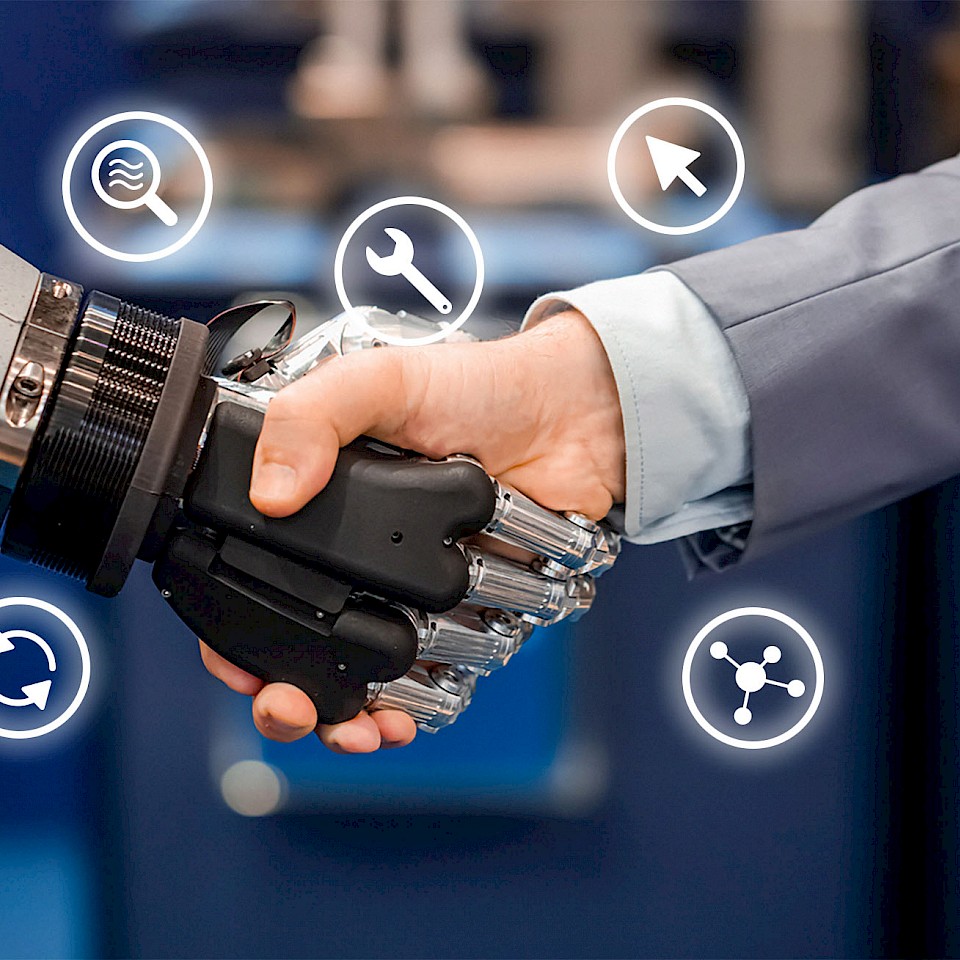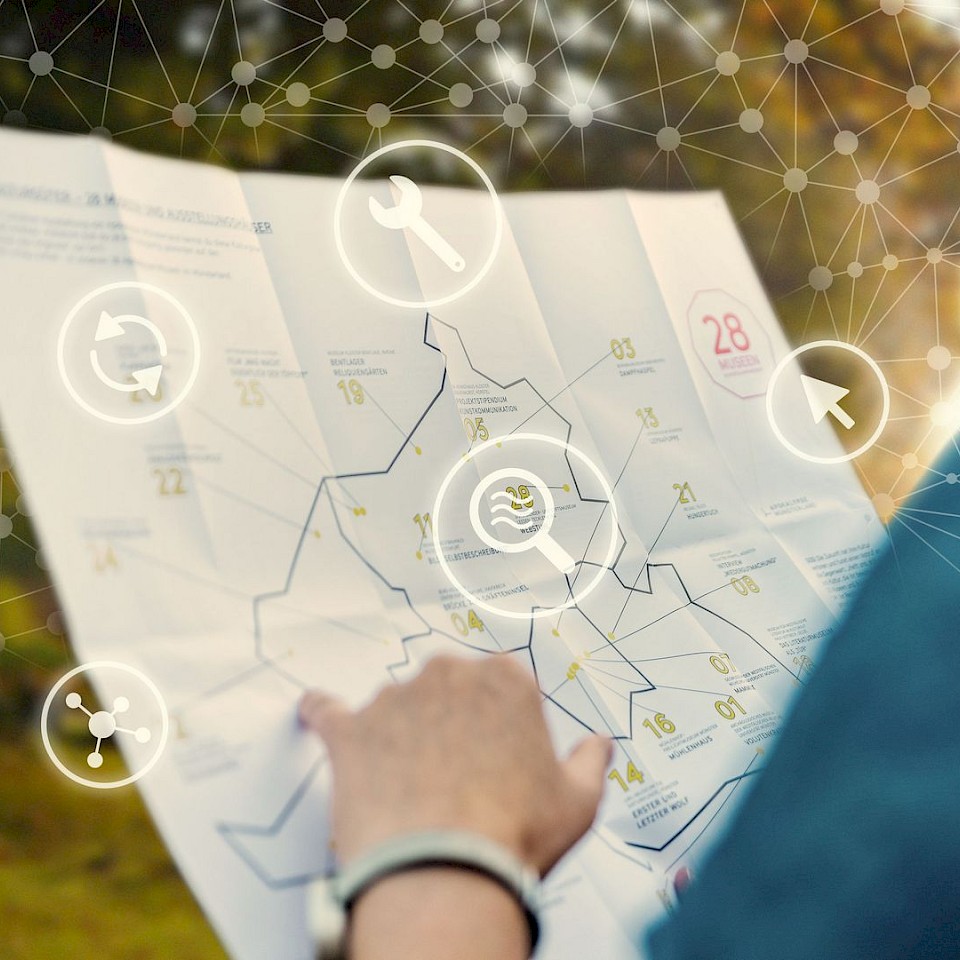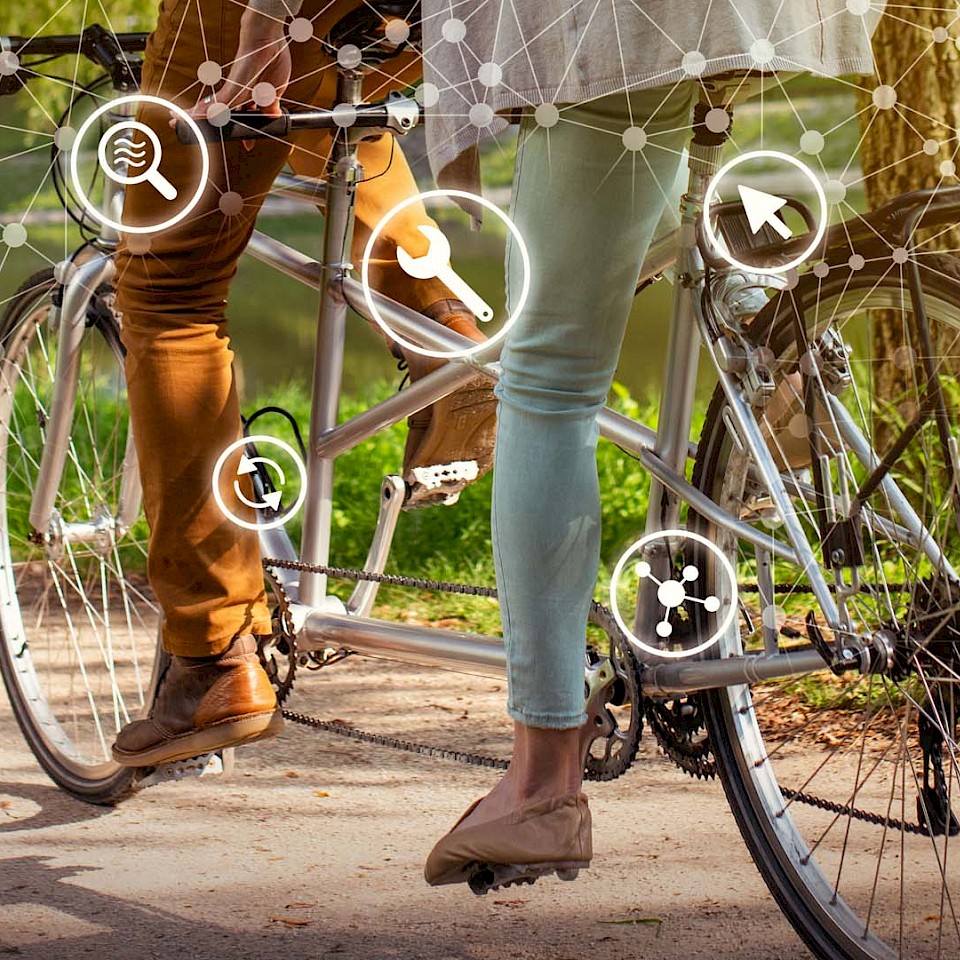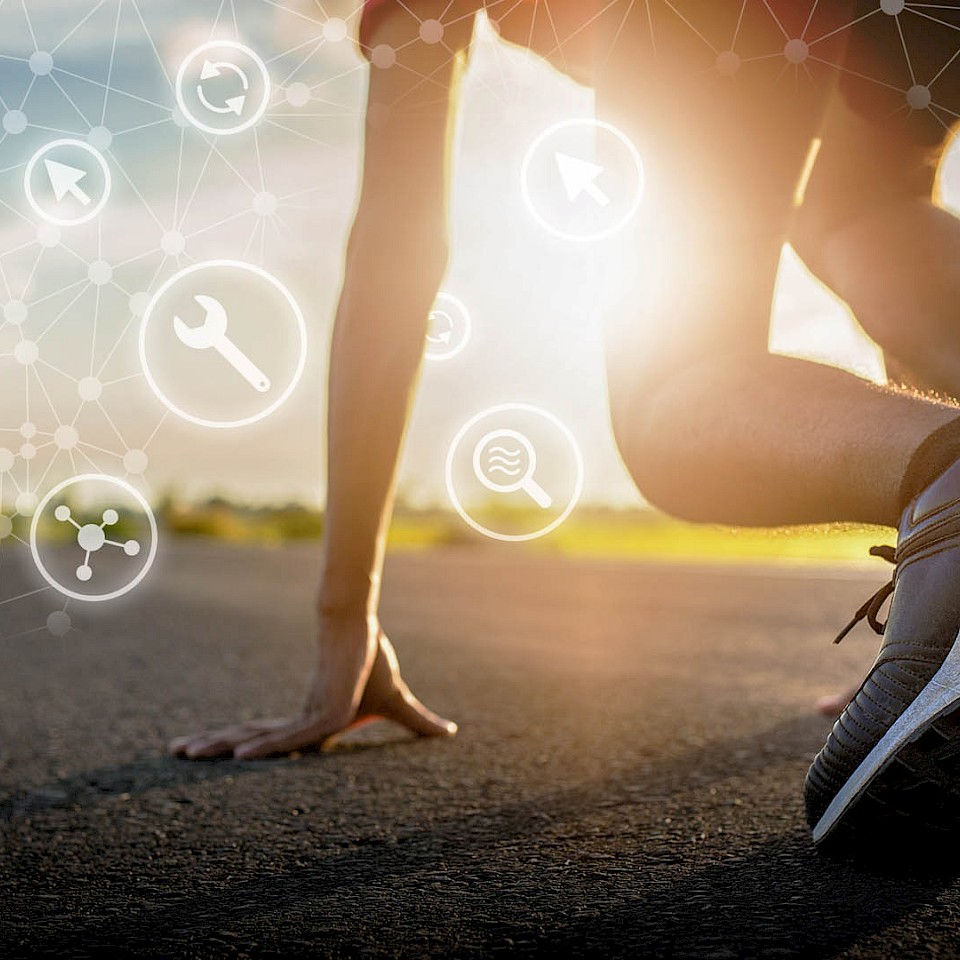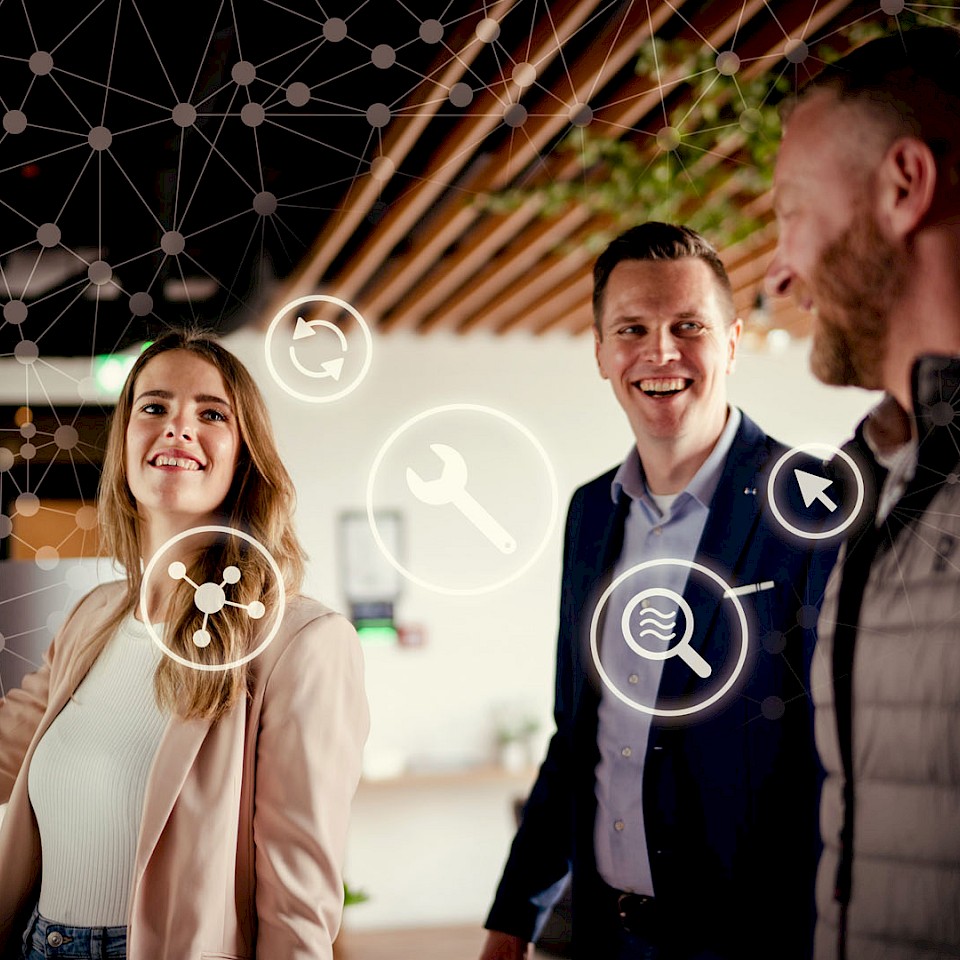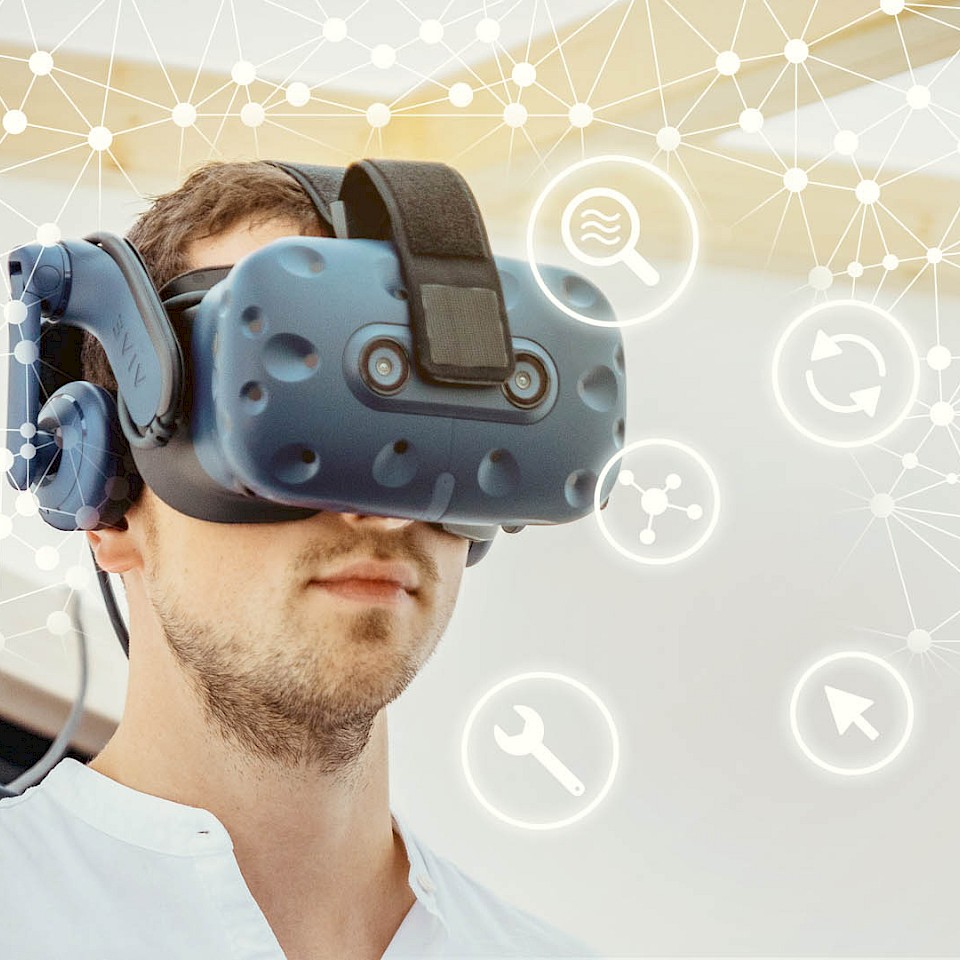+++ Tech-Ticker Münsterland +++
The Tech-Ticker Münsterland delivers what the name promises: It provides concise reports on technological developments in and from the region. With information that is relevant for technology development in Münsterland. Our tech scouts research, evaluate and select information from the technology Münsterland and keep you up to date with their ticker news. These are published at short intervals in the social media and in collected form here on our homepage.
Exciting news at a glance
22.11.2022: What makes a city smart? How can we make our region more liveable? Which technologies and which digital measures will help us make our municipalities fit for the future?
These and many other questions are to be answered by the "Smarter Kreis Borken" project of the business development agency for the district of Borken, headed by Hendrik Gericks. And the best part? We can incorporate our own ideas!
On this page we can submit ideas and concepts to make the district of Borken smart. The six fields of action are
- Mobility
- Environment & Climate
- Energy
- Leisure, Culture & Tourism
- Society & Living Together
- Economy & Work
in the foreground.
So what are you waiting for? Let's go!
Christopher Langner, Westphalian University of Applied Sciences, Technology Scout Engineering Pro
21.11.2022: Sensory prostheses are already widely used in medicine, for example to enable people to hear again. These sensory prostheses take in information from the outside world and convert it into electrical signals that are sent to the brain's processing centres.
The other type of neuroprosthesis takes electrical signals from the brain and converts them into signals that control something in the outside world, such as the output of words on a screen.
Researchers have now recorded signals from the motor cortex that are responsible for controlling the vocal tract. The sensors were implanted in a man who had been paralysed for 15 years. The researchers' task was now to find the connection between the brain's activity patterns and the words thought or spoken. To do this, they relied on voluntary data from patients.
A neural network trained with the brain activity data set (input) and the muscle activity data set (output) can detect associations between the data sets. Since the association between the data is trained, the neural network can ultimately determine which word the patient is thinking of based only on the brain activity.
The goal is to capture 100 words per minute from thoughts. That would be about twice as many words as an average adult can manage with keyboard input.
"[...] we are enormously proud of what we have achieved so far. But we're just getting started."
Lukas Rengbers, FH Münster, technology scout, MakerSpace Steinfurt employee
15.11.2022: Who hasn't seen them, the futuristic hospitals from science fiction films, where a sick body is analysed in seconds and the best possible therapy and the latest therapeutic procedures and surgical interventions are initiated immediately.
This idea still seems far in the future, but AI can bring this vision much closer to the present. In the meantime, there are a multitude of AI applications that are already moving strongly in the direction of the science fiction vision. A few selected examples:
Computer Aided Detection:
In particular, the detection of diseases on the basis of image material (X-ray, MRI, CT, photos, etc.) has been greatly developed in recent years. This makes it possible to obtain an initial, but already very accurate, assessment of the disease within seconds on the basis of a broad database.
Semantic text understanding:
Doctors are already well occupied with their daily business, so there is not enough time to read hundreds of patient reports. An AI, on the other hand, can go through millions of reports in a very short time and then provide the right answers to specific questions. We know something similar from home assistants like Alexa or Google, which immediately give us the right answer to the question "When was Münster University of Applied Sciences founded".
Forecasting:
Since our bodies are similar in terms of diseases and their progression, it is possible to recognise patterns in the temporal data streams generated by sensors. This makes it possible to predict the length of stay, mortality or risk factors of patients. This not only helps the patients, but also the administration, controlling and logistics management of the hospital.
The basic prerequisites for AI applications are data and a digital infrastructure. In the third expansion stage of the ePA (electronic patient record), data can also be made available to research on a voluntary basis from 2023. Everyone can join in and share their data via the ePA smartphone app. This data can then be used to develop new data-based applications.
Frauenhofer IAIS is now offering a free AI readiness check. This is intended to help hospitals carry out a self-evaluation and provide recommendations for action.
Click here for the AI Readiness Check.
Lukas Rengbers, Münster University of Applied Sciences, technology scout, employee of the MakerSpace Steinfurt
11.11.2022: Slept through technology trends and lost touch? Not with us!
We at Münsterland e.V. have created a free workshop offer on technology scouting to prevent this!
In the workshops, I talk about technologies and trends, about systematic technology scouting and the implementation of new technologies in the existing business model.
Sounds exciting? Then go for it!
The workshops will take place on the following dates:
14.11.2022 | 14:00 - 17:00 at WFG in Ahaus
22.11.2022 | 10:00 - 14:00 at WFC in Coesfeld, WESLINK Business Center
Ms Kathrin Bonhoff will accept registrations for and from the district of Borken, Ms Sally Friedrich will take care of registrations for and from the district of Coesfeld.
I look forward to an exciting discussion!
Christopher Langner, Westphalian University, Technologiescout Engineering Pro
7.11.2022: Every time a person enters a tunnel mouth of a train line, the line must be walked by personnel. As false alarms are frequent, lines are often closed unnecessarily. With 700 tunnel mouths to monitor, this leads to a very high control effort. False alarms occur because the automatic signal evaluation used so far does not guarantee reliable detection of people. Animals or environmental influences are often recognised as persons. This is where "classic video surveillance" reaches its limits.
Artificial intelligence should now provide a remedy. By using dynamic vision sensors and a customised object recognition algorithm, persons are to be reliably recognised in the future. A dynamic vision sensor (DVS) is an imaging sensor that, unlike classic cameras, does not record "complete" images, but only reacts to changes above a certain threshold in the scene being viewed. The DB Station&Service AG and the Niederrhein University of Applied Sciences as well as the Federal Police and Masasana GmbH are involved in the funded project TuNuKi.
More information is available here.
Lukas Rengbers, Münster University of Applied Sciences, technology scout, employee of the MakerSpace Steinfurt
18.10.2022: You can think of the Metaverse as the next generation of the internet in a real-time rendered 3D virtual environment. Today, a graphical user interface (2D) is typically used to interact with the internet. An immersive 3D environment, in which virtual 3D models are superimposed on physical objects, opens up an additional layer of interaction. This additional layer offers immense new possibilities.
You may be familiar with virtual walk-throughs or 360-degree images on social media platforms (2D), where you can already get a good impression of premises.
However, the Metaverse goes much further. It creates a kind of digital twin of the world in which users can see each other and interact with each other. In the process, the appearance of the virtual avatar can match one's own appearance and facial expressions very closely by means of facetracking (see Codec Avatar).
The metaverse also offers many possibilities for industry. Collaborative work on projects can be done via AR/VR workspaces. Employees can be trained remotely on virtual machines to test work processes safely. Prototypes or product demonstrations can be implemented interactively and independent of location. In the production environment, forklift drivers can see silhouettes of people behind objects that are not normally visible. AR mounts for superstructures of all kinds support employees and simplify their work. If questions arise, expert personnel can provide interactive support remotely. Proof of ownership of digital goods, e.g. assests of the digital twin, becomes unique and thus secure through NFT (Non-Fungible Token) via blockchain. Payments can be made with cryptocurrencies and contracts become more secure via smart contracts. The use of machine learning and object recognition will become much more relevant. Information on physical objects, such as production goods, can be virtually superimposed directly on the object by asking a question in combination with eye tracking and object recognition. Lengthy searches for information are thus no longer necessary. This is what the future of the Metaverse could look like.
You don't know exactly what is meant by Machine Learning, AR, VR, Digital Twin, NFT, Smart Contract etc.? Then go to the TechKompass here.
Lukas Rengbers, Münster University of Applied Sciences, technology scout, MakerSpace Steinfurt employee
5.10.2022: EuroTier is a trade fair for the livestock industry and awards the Innovation Prize for innovations in agriculture every two years.
The company Wasserbauer GmbH has now been awarded the golden innovation prize for the "Active-Cleaner cleaning robot". The Active-Cleaner is a fully automatic stable system based on an AI workflow that recognises and subsequently disposes of horse manure on the farm by analysing data in real time. The camera technology used can also detect multiple horse manure accumulations. The best disposal route is then determined automatically.
Behind this is the technical know-how of the Münsterland company "Zauberzeug GmbH" from Havixbeck! Zauberzeug GmbH has been working on this vision since 2012 and has secured the results with a number of patents. Through the cooperation with Wasserbauer GmbH, series production, international sales and support are now also secured. A win-win situation for all partners. This is how successful cooperation works!
More information is available here.
Lukas Rengbers, FH Münster, technology scout, employee of the MakerSpace Steinfurt
05.10.2022: It's obvious, naturally from Münsterland!
The company Weicon from Münster presented a world first at the hardware fair in Cologne - a stripping tool whose material is based on vegetable oils and natural waxes, fibres and minerals.
"Shaping the future sustainably" - Weicon is showing the way. When will you follow suit?
You can find more information here.
Christopher Langner, Westphalian University, Technology Scout Engineering Pro
26.09.2022: Proteins consist of long chains of amino acids that form complex 3D structures. The number of possible configurations of the amino acid chain is enormous. In order to understand the function of a protein, the determination of the protein structure is crucial. Until now, this has been determined experimentally using time-consuming and costly techniques such as X-ray crystallography.
Now DeepMind has further developed the AlphaFold programme, a neural network that is able to calculate the structures of almost all naturally occurring proteins based on amino acid sequences. The AlphaFold protein structure database is free to use.
The prediction of protein structures can have very far-reaching effects. On the one hand, it can dramatically speed up drug development, leading to new malaria vaccines, for example. But it will also have a major impact on the development of drugs tailored to individual patients (precision medicine). Another example is the development of new enzymes that can degrade plastics.
Several start-ups worth billions are expected to emerge in the coming decade in view of the rapid developments and achieve unimagined breakthroughs. The revenue generated by AI in healthcare is estimated to be around $45.2 billion by 2026.
A study of German AI start-ups from 2020 found that around 16 percent of German AI start-ups are in the healthcare and pharmaceutical sector. This is the largest sector share.
So we can be very excited about how our lives will be changed by the rapid developments in the field of AI.
You can find more information here.
Lukas Rengbers, Münster University of Applied Sciences, technology scout, employee of the MakerSpace Steinfurt
21.09.2022: For years we have been trying to minimise physical labour through automation solutions and to design ergonomically safe workplaces.
But what happens when human labour is irreplaceable? Then exoskeletons come into play!
Exoskeletons are mechanical scaffolds that are attached to the outer body and support it during work. An exoskeleton is by no means a forklift truck that can be put on, nor does it give superpowers. Rather, it protects the wearer from stress peaks, thus making the activity easier and extending the time until physical fatigue.
I was allowed to try out the active exoskeleton from the company exoIQ and was very enthusiastic about how it relieves the arms during overhead work!
Want to know more about exoskeletons? Have a look here!
Christopher Langner, Westfälische Hochschule, Technology Scout Engineering Pro
19.09.2022: Suitable electricity storage systems are playing an increasingly important role in the generation of renewable energies, such as electricity from PV systems. Compared to Li-ion batteries (=liquid electrolyte batteries), solid-state batteries based on silicon are associated with fewer safety risks and it is possible to use other anode materials. This makes it possible to store more energy in the same space.
In the BMBF-funded joint project SilKompAs, Prof. Dr. Wolfgang Zeier's group is researching the optimisation of the processing of anode material for such silicon-based solid-state batteries. Other partners in the project are EL-CELL GmbH, the Institute for Particle Technology at the Technical University of Braunschweig, the Institute of Physical Chemistry at the Justus Liebig University of Giessen, SGL Carbon, Thermo Fisher Scientific and M. Braun Inertgas-Systeme GmbH.
Dr. Wiebke Wessling, Surface Network NRW e.V., Technology Scout for Materials & Surfaces
31.08.2022: For some product applications it is essential that the material used has certain properties. For example, a material for medical technology must be impermeable to radiation, while a material for use in electrical engineering must be conductive.
Companies from the additive manufacturing sector are busy all over the world creating materials with special properties and turning them into technologically advanced products for various applications using additive manufacturing.
Further information is available here.
Christopher Langner, Westphalian University of Applied Sciences, Technology Scout Engineering Pro
31.08.2022: As computer vision applications become more widespread, there is a growing need for easy ways to train the models working in the background using a few images.
Many companies are unable to train their own models due to a lack of AI or machine learning experts and data scientists. In addition, a large number of annotated images are usually required to train a reliable model.
The company "Zauberzeug" from Havixbeck in Münsterland recognised this problem early on and developed a solution, the "Learning Loop". The "Zauberzeug Learning Loop" offers companies the possibility to train reliable computer vision models with only a few images. For this purpose, "Zauberzeug" provides companies with a powerful no-code web platform. The training process can be run through without AI expert knowledge via the intuitive Kanban user interface.
In addition, users can continuously upload new images from their own use case via a simple API. These are automatically sorted and prioritised. Only images that provide real added value for the AI need to be annotated. Quality instead of quantity, in other words. The total amount of data to be processed can thus be significantly reduced.
After annotation, the new data flows into the next training. The resulting AI model can then be conveniently installed on the production systems from the web interface in order to subsequently process new images. All in all, this process is very similar to Tesla's fleet learning.
Lukas Rengbers, Münster University of Applied Sciences, Technology Scout, MakerSpace Steinfurt employee
22.08.2022: Anyone who is already involved with or using artificial intelligence or machine learning applications has certainly already noticed that data is essential to obtain reliable predictions about, for example, production quality (predictive quality) or failing machine parts (predictive maintenance). But production data can also help to increase overall plant effectiveness and much more.
Generating all this data yourself until sufficient data is available is often a time-consuming undertaking. It would be easier if companies "exchanged" the data generated in the production process with each other in order to train AI models. However, many companies see their trade secrets at risk or fear a threat to intellectual property.
Through the use of federated learning, nothing now stands in the way of trusting collaboration at all levels, as it is no longer necessarily the data that is shared, but the knowledge generated from it.
Provider Apheris has developed a platform where data from multiple companies can be used to train AI models without compromising their trade secrets, privacy or intellectual property.
Data is not only important in manufacturing. You can find more applications on the provider's website.
Lukas Rengbers, TAFH Münster, Technology Scout for Digital Solutions
19.08.2022: The innovation consulting department of WFG Borken organises the PdM regulars' table four times a year. All those interested in PdM can exchange views on this topic or gain initial experience.
The next regulars' table will take place on 07.09 from 17:30-19:00 at Bonfire in Borken.
The focus of this event is the explanation and application of the PdM guide for small and medium-sized enterprises.
Birgit Helms, Franz-Josef Peitzmann and Bernd Liesbrock will be present.
Further information is available here.
Christopher Langner, Westphalian University, Technologiescout Engineering Pro
03.08.2022: By 2030, Europe will need at least 20 battery manufacturing gigafactories to meet the growing demand for technologically advanced batteries.
But where should these production facilities be built in terms of costs, skills, know-how, the availability of clean energy and many other factors? Researchers at the WWU Münster have investigated this question.
The studies show that France, Lithuania and Germany are suitable locations. However, no EU country leads in all factors, so battery manufacturers have to weigh the individual factors against each other to determine a suitable location.
More information is available here.
Christopher Langner, Westphalian University of Applied Sciences, Technologiescout Engineering Pro
27.07.2022: High productivity with the greatest possible flexibility - these requirements have become particularly apparent in recent years and have been intensified especially by delivery bottlenecks.
Audi is now investigating whether the use of driverless transport systems and flexible manufacturing islands makes sense alongside conventional assembly line production. Assembly can thus be adapted more flexibly and easily to supply and demand.
The pilot project concerns the assembly of customised interior door panels. Here, for example, lighting elements or sun blinds are installed. As soon as this equipment variant is not configured, the vehicle skips this production island and continues to run on the assembly line.
Further information is available here: MaschinenMarkt
Is it time to rethink our tried and tested manufacturing systems and make them fit for today's requirements with the help of new technologies?
Christopher Langner, Westphalian University, Technology Scout Engineering Pro
20.07.2022: Whether it's screwing a motorbike, building concrete furniture or creating an entire home cinema - we can all take a leaf out of Mats Schulte's book! For the 17-year-old, a dream is now coming true: The student is allowed to fly to NASA in Houston and design a Mars mission within a simulation game.
Read more about the tinkerer here: ARD-Mediathek
Christopher Langner, Westphalian University of Applied Sciences, Technologiescout Engineering Pro
13.07.2022: A ketchup bottle can be held upside down without the ketchup flowing out. With enough pressure, the ketchup can be squeezed out of the bottle. If you press too hard, the ketchup squirts out uncontrollably - what a mess!
A group of researchers from the Netherlands is using this principle of pressure control via a so-called hysteretic valve to make soft robots react automatically to their environment. Control via valve technology eliminates the need for computer control, which is why the soft robots can act in an extremely energy-efficient manner.
How cool is that? More info and a video here.
Christopher Langner, Westfälische Hochschule, Technologiescout Engineering Pro
11.07.2022: Everyone is talking about artificial intelligence, or AI for short: not least, this technology is seen as having the potential to revolutionise our companies and society.
But what exactly is artificial intelligence? And what are its limits? For which problems can artificial intelligence be used in companies in a value-creating way and what prerequisites must be created for this?
These and other questions will be answered by the further education series "Artificial Intelligence", which the IPD is offering in cooperation with the Bundesverband Mittelständische Wirtschaft (BVMW e.V.).
From 19 October to 30 November, you will learn important basics of artificial intelligence in four seminars.
You can find more information about the training series here.
More information about the Institute for Process Management and Digital Transformation (IPD).
Lukas Rengbers, technology scout, employee of the MakerSpace Steinfurt
20.06.2022: A popular tool for creating 3D models is photogrammetry. In this process, an object is photographed from different positions and angles. Then, the photogrammetry software uses the metadata recorded when the photo was taken (focus length, camera parameters, etc.) as well as pixel values to calculate the position of the camera while taking the photo using machine learning algorithms. A three-dimensional mesh of the object is then calculated. The resulting mesh initially contains no coloured external appearance. The software then provides the surfaces of the three-dimensional networked object with 2D images (the so-called textures) using so-called "texture mapping". Previously, photogrammetry software took many minutes or even hours to calculate 3D models from photographs. In addition, a large number of photos with overlapping content were required for the software to satisfactorily reconstruct the object.
Nvidea has now developed the product "Instant NeRF". This promises to reconstruct 3D models through a small number of images in a few minutes, drastically reducing rendering time. This involves deconstructing the light from a photo (reverse ray tracing - neural radiation fields). The AI methods thus try to understand how light works in order to determine the position of objects from photos.
Google already has a large selection of images from satellite data, Streetview 360° photos and user photos and now wants to use them for its new Google Maps feature "Immersive View" to create 3D models of entire cities. This will allow users to discover new places in an immersive way in the future. This will certainly also offer great added value for the Metaverse.
The city of Münster is also active in this area and, together with Münster University of Applied Sciences, has developed a smart city exploration app for Android and IOS that uses augmented reality (AR) to allow users to experience virtual objects in selected locations. The app is called "Explore Münster - your city tour" and is not only a great way for guests to experience the city from a completely new perspective.
NVIDIA Instant NeRF: developer.nvidia.com
Google Immersive View: www.googlewatchblog.de
Explore Münster - your city tour: www.xn--mnster-inside-wob.de
Lukas Rengbers, TAFH Münster, Technology Scout for Digital Solutions
13.06.2022: Humans have always been inspired by nature to create new technical innovations. BASF Coatings in Münster, for example, has developed a surface coating for aircraft that mimics shark skin to reduce fuel consumption.
This adoption from nature is also found in the new generation of computers. So-called neuromorphic computers are not based on the Von Neumann architecture, which provides a clear separation between memory and processor and is so far mainly found in smartphones, computers, etc., but are modelled on the neural networks of humans. The problem of the limited transfer speed of data between the memory and the processor does not exist in contrast to the Von Neumann architecture (Von Neumann bottleneck).
A completely new technology must therefore be used to exceed the technical performance limit of today's computers. In addition to quantum computers, neuromorphic computer chips are capable of processing and storing information simultaneously. They are thus not only faster, but also much more energy-efficient.
Training large ML models in particular requires extremely large amounts of energy with conventional computers. Since this energy has so far not necessarily come from renewable sources, carbon dioxide emissions also increase with increasing data processing.
Functionality using the Intel Loihi 2 chip as an example
Lukas Rengbers, Münster University of Applied Sciences, technology scout, employee of the MakerSpace Steinfurt
03.06.2022: An energy consultation is a snapshot - afterwards the gas price rises, there is no more oil and crises require a rethink. What now?
Kerith GbR from Münster has developed an energy strategy monitor that helps companies plan energy resources and develop energy-saving measures. Dynamic factors are taken into account so that the evaluation of individual measures can be carried out in a way that is as appropriate as possible to the situation.
The Digital Summit Euregio awarded this idea with a StartUp Award. Congratulations to the Kerith GbR team!
More information is available here.
Christopher Langner, Westphalian University, Technologiescout Engineering Pro
03.06.2022: In search of images for our TechKompass, I scoured several stock photography collections to find a suitable image that met my expectations. In the end, some of the selected images did not exactly match my expectations. The creation of the image material by an external service provider would have involved a lot of arrangement and high costs.
Can't it be simpler and faster?
The answers are provided by Google with its product "Imagen" and OpenAI with "DALL-E 2". The products are so-called text-to-image diffusion models with deep language understanding. By simply describing the image presented, the AI creates it in seconds. There are no limits to the imagination. To understand the text, the products draw on the power of large transformer language models such as GPT-3. Further use cases can be found on the manufacturer's pages listed below. The functionalities of the models are described in the blog posts listed below.
Google Imagen: imagen.research.google
Google AI Blog: ai.googleblog.com
Dall-E 2: openai.com/dall-e-2/
Dall-E 2 Blog: assemblyai.com/blog/how-dall-e-2-actually-works/
When the metaverse reaches the masses, many 3D models will certainly be needed. Will these also be able to be created by diffusion models in the future?
Lukas Rengbers, technology scout, employee of the MakerSpace Steinfurt
19.05.2022: We are all familiar with product recalls by food manufacturers from the media. One reason for the recall is often foreign bodies that were not detected during production or filling. CLK GmbH has taken on the problem and developed the "MultiCheck" system solution together with Prof. Jürgen te Vrugt from Münster University of Applied Sciences. The solution has now been awarded the seifriz 2022 technology transfer prize.
The optical system can detect foreign bodies during the filling of product streams with almost 100 percent certainty, provided they are different in colour from the product to be filled and have a size of at least 2 mm x 2 mm. This also makes it possible to detect foreign bodies made of plastic, for which electromagnetic methods are unsuitable.
The flow of goods is tracked in free fall by four cameras. Several images of a fall sequence are evaluated, so that foreign bodies located in the middle of the material flow can also be detected. Safe detection is supported by the use of a powerful LED illumination unit. The system can reliably inspect up to 100 drops per minute for foreign objects.
Due to its adaptability to almost any multihead weigher, the system solution is certainly interesting for many users.
The product brochure is available here.
Lukas Rengbers, technology scout, employee of the MakerSpace Steinfurt
As a regional network initiative, Enabling Networks Münsterland supports companies and universities in the Münsterland region in developing innovations, implementing them and finding the right partners for the project. This also includes technology scouting. This involves the creation of five technology scouts who support companies in the development of new innovations. And at this point they regularly tick about news from the technology sector.
The Enabling Networks project is funded by the European Union and the NRW Ministry of Economics as part of the ERDF call "Regio.NRW".




